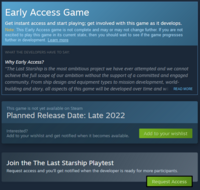Getting Started
The Last Starship is a sandbox spaceship management game being developed by Introversion Software and is currently in early pre-alpha playtest on Steam. For this reason, there is currently very little guidance on getting started with the game.
How to get the game
Since the game is currently in pre-alpha playtest, it is unavailable for purchase. To get a copy, one must go to the game's Steam page and request access to the playtest. Once a player has been granted access to the playtest, they can install the game through Steam and begin playing.
After the first game session and after the first game session following an update, a survey will open in the default browser. The survey asks questions about the player's experiences with the game and what they think about its future.
Game modes
The game is split into two modes: Regular Play and Ship Creation. The two modes appear identical, with Ship Creation starting with the Debug menu active to allow loading out a ship without spending money or waiting for parts to arrive. The Debug menu is also available in Regular Play but is not opened by default.
All Regular Play game modes start you off with a specific empty vessel
Building the first ship
- For advanced information on building various ship systems via the Debug menu or after acquiring enough currency, see our other Getting Started articles.
At the start of Regular Play, you have only an empty vessel in a system with trade and story contracts, but no shipyard. The exceptions are the The Praxis, which starts with some materials, and Shipyard, which starts the game in a system with a shipyard. A few crew members in space suits arrive via shuttle in the first few moments of the game, and it is up to the player to turn this vessel into a functioning ship.
The Make your new ship ready for flight contract involves setting up these systems, so it is a good idea to accept that contract before beginning this setup. It is also a good idea to skim the rest of this article. It is currently impossible for pipes containing different materials to coexist in the same tiles or be in adjacent tiles. It is also impossible to rotate engines. Therefore, it is essential to plan the layout to account for this.
Power
Before installing any systems, you must have power on the ship. Almost every piece of equipment available requires a source of power. If you selected the Praxis vessel, you should already have some or all necessary items. Otherwise, purchase the following items from the Trade screen.
Place the reactor and one loader together somewhere in your vessel's interior. It may be most efficient to place this close to where you intend to build your engines, as the reactor and engines are the main components that require fuel. Connect the reactor's fuel connector to the loader's output. A crew member should immediately pick up a fuel canister and deposit it on the loader. After a moment of spinup, your reactor will spring to life, ready to provide power to your ship.
Atmosphere
The crew members have enough oxygen to survive without an atmosphere for several minutes, so there is some flexibility in the order that the player can build systems. That said, a working atmosphere means the player doesn't need to rush and can lay things out the way they want. Therefore, we will begin by establishing essential Life Support. Purchase the following items from the Trade screen:
Similarly to how we set up our power system, place the airduct and loader together. Connect the airduct's oxygen connector to the loader's output and the power connector to the reactor's power output. Once a crew member has loaded an oxygen canister into the loader, your airduct will begin pumping that oxygen into the ship's atmosphere.
You can select the Atmosphere overlay to see the interior change from a lattice pattern to red horizontal lines. The lines will progress towards green and expand to fill their tiles as oxygen fills the atmosphere. Once the atmosphere is sufficient to sustain them, the crew members will begin to remove their space suits and transfer them to the cargo storage area. Keeping the space suits on hand is good in a hull breach during battle or if there is a blockage in your life support system.
Propulsion and FTL
Propulsion and FTL are necessary for your ship to travel within and between systems in a sector and to progress to new sectors. Purchase the following items from the Trade screen:
- Engines - The size of a ship affects its mass and inertia, so large ships require more engines than smaller ships. Two engines are a good start for the Praxis and Sleek vessels.
- FTL Drive
Engines must be placed into the ship's outer hull, with propulsion directed to the left of the screen. It is currently not possible to rotate engines. Once they are placed, connect the engine's power and fuel connectors to the same pipe and cable setup from your reactor.
In addition to engines and FTL, installing some thrusters on your ship is also a good idea. Thrusters allow for fine motor control during Contract#Combat or when mining asteroids or docking with ships.
